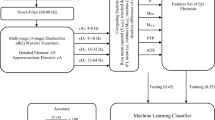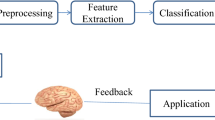Abstract
Functional near-infrared spectroscopy (fNIRS) is an emerging optical technique, which can assess brain activities associated with tasks. In this study, six participants were asked to perform three imageries of hand clenching associated with force and speed, respectively. Joint mutual information (JMI) criterion was used to extract the optimal features of hemodynamic responses. And extreme learning machine (ELM) was employed to be the classifier. ELM solved the major bottleneck of feedforward neural networks in learning speed, this classifier was easily implemented and less sensitive to specified parameters. The 2-class fNIRS-BCI system was firstly built with an average accuracy of 76.7 %, when all force and speed tasks were categorized as one class, respectively. The multi-class systems based on different levels of force and speed attempted to be investigated, the accuracies were moderate. This study provided a novel paradigm for establishing fNIRS-BCI system, and provided a possibility to produce more degrees of freedom in BCI system.





Similar content being viewed by others
References
Coyle, S. M., Ward, T. E., and Markham, C. M., Brain-computer interface using a simplified functional near-infrared spectroscopy system. J. Neural Eng. 4(3):219–226, 2007. doi:10.1088/1741-2560/4/3/007.
Fazli, S., Mehnert, J., Steinbrink, J., Curio, G., Villringer, A., Muller, K. R., and Blankertz, B., Enhanced performance by a hybrid NIRS-EEG brain computer interface. Neuroimage 59(1):519–529, 2012. doi:10.1016/j.neuroimage.2011.07.084.
Birbaumer, N., Breaking the silence: brain-computer interfaces (BCI) for communication and motor control. Psychophysiology 43(6):517–532, 2006. doi:10.1111/j.1469-8986.2006.00456.x.
Mcfarland, D. J., and Wolpaw, J. R., Brain-computer interfaces for communication and control. Clin. Neurophysiol. 113(6):767–791, 2002. doi:10.1016/S1388-2457(02)00057-3.
Şen, B., Peker, M., Çavuşoğlu, A., and Çelebi, F. V., A comparative study on classification of sleep stage based on EEG signals using feature selection and classification algorithms. J. Med. Syst. 38(3):1–21, 2014. doi:10.1007/s10916-014-0018-0.
Zhang, L., He, W., He, C., and Wang, P., Improving mental task classification by adding high frequency band information. J. Med. Syst. 34(1):51–60, 2010. doi:10.1007/s10916-008-9215-z.
Egger, J., Kappus, C., Freisleben, B., and Nimsky, C., A medical software system for volumetric analysis of cerebral pathologies in magnetic resonance imaging (MRI) data. J. Med. Syst. 36(4):2097–2109, 2012. doi:10.1007/s10916-011-9673-6.
Kimura, Y., Tanaka, T., Higashi, H., and Morikawa, N., SSVEP-based brain-computer interfaces using FSK-modulated visual stimuli. IEEE Trans. Biomed. Eng. 60(10):2831–2838, 2013. doi:10.1109/TBME.2013.2265260.
Li, Y. Q., Pan, J. H., Wang, F., and Yu, Z. L., A hybrid BCI system combining P300 and SSVEP and its application to wheelchair control. IEEE Trans. Biomed. Eng. 60(11):3156–3166, 2013. doi:10.1109/TBME.2013.2270283.
Everdell, N. L., Gibson, A. P., Tullis, I. D. C., Vaithianathan, T., Hebden, J. C., and Delpy, D. T., A frequency multiplexed near-infrared topography system for imaging functional activation in the brain. Rev. Sci. Instrum. 76(9):093705, 2005.
Chen, M., Guan, J. N., and Liu, H. H., Enabling fast brain-computer interaction by single-trial extraction of visual evoked potentials. J. Med. Syst. 35(5):1323–1331, 2011. doi:10.1007/s10916-011-9696-z.
Rodriguez-Bermudez, G., and Garcia-Laencina, P. J., Automatic and adaptive classification of electroencephalographic signals for brain computer interfaces. J. Med. Syst. 36(1):S51–S63, 2012. doi:10.1007/s10916-012-9893-4.
Sitaram, R., Caria, A., and Birbaumer, N., Hemodynamic brain-computer interfaces for communication and rehabilitation. Neural Netw. 22(9):1320–1328, 2009. doi:10.1016/j.neunet.2009.05.009.
Coyle, S., Ward, T., Markham, C., and Mcdarby, G., On the suitability of near-infrared (NIR) systems for next-generation brain–computer interfaces. Physiol. Meas. 25(4):815–822, 2004. doi:10.1088/0967-3334/25/4/003.
Naseer, N., and Hong, K., fNIRS-based brain-computer interfaces: a review. Front. Hum. Neurosci. 2015. doi:10.3389/fnhum.2015.00003. 9(3).
Naseer, N., Hong, M. J., and Hong, K. S., Online binary decision decoding using functional near-infrared spectroscopy for the development of brain–computer interface. Eep. Brain. Res. 232(2):555–564, 2014. doi:10.1007/s00221-013-3764-1.
Matthews, F., Pearlmutter, B. A., Ward, T. E., Soraghan, C., and Markham, C., Hemodynamics for brain-computer interfaces. IEEE Signal Proc. Mag. 25(1):87–94, 2008. doi:10.1109/MSP.2008.4408445.
Cui, X., Bray, S., Bryant, D. M., Glover, G. H., and Reiss, A. L., A quantitative comparison of NIRS and fMRI across multiple cognitive tasks. NeuroImage 54(4):2808–2821, 2011. doi:10.1016/j.neuroimage.2010.10.069.
Villringer, A., Planck, J., and Hock, C., Near infrared spectroscopy (NIRS): a new tool to study hemodynamic changes during activation of brain function in human adults. Neurosci. Lett. 154(1):101–104, 1993. doi:10.1016/0304-3940(93)90181-J.
Huppert, T. J., Hoge, R. D., Diamond, S. G., Franceschini, M. A., Boas, A. D. A., and Onaral, B., A temporal comparison of BOLD, ASL, and NIRS hemodynamic responses to motor stimuli in adult humans. Neuroimage 29(2):368–382, 2009. doi:10.1016/j.neuroimage.2005.08.065.
Ferrari, M., and Quaresima, V., A brief review on the history of human functional near-infrared spectroscopy (fNIRS) development and fields of application. Neuroimage 63(2):921–935, 2012. doi:10.1016/j.neuroimage.2012.03.049.
Power, S. D., Falk, T. H., and Chau, T., Classification of prefrontal activity due to mental arithmetic and music imagery using hidden Markov models and frequency domain near-infrared spectroscopy. J. Neural Eng. 7(2):26002, 2010. doi:10.1088/1741-2560/7/2/026002.
Luu, S., and Chau, T., Decoding subjective preference from single-trial near-infrared spectroscopy signals. J. Neural Eng. 6(1):016003, 2009. doi:10.1088/1741-2560/6/1/016003.
Naseer, N., and Hong, K.-S., Classification of functional near-infrared spectroscopy signals corresponding to the right- and left-wrist motor imagery for development of a brain-computer interface. Neurosci. Lett. 553:84–89, 2013. doi:10.1016/j.neulet.2013.08.021.
Sitaram, R., Zhang, H. H., Guan, C. T., Thulasidas, M., Hoshi, Y., Ishikawa, A., Shimizu, K., and Birbaumer, N., Temporal classification of multichannel near-infrared spectroscopy signals of motor imagery for developing a brain-computer interface. Neuroimage 34(4):1416–1427, 2007. doi:10.1016/j.neuroimage.2006.11.005.
Hong, K.-S., Naseer, N., and Kim, Y.-H., Classification of prefrontal and motor cortex signals for three-class fNIRS–BCI. Neurosci. Lett. 587:87–92, 2015. doi:10.1016/j.neulet.2014.12.029.
Khan, M. J., Hong, M. J. Y., and Hong, K. S., Decoding of four movement directions using hybrid NIRS-EEG brain-computer interface. Front. Hum. Neurosci. 8:244, 2014. doi:10.3389/fnhum.2014.00244.
Cope, M., The development of a near infrared spectroscopy system and its application for non invasive monitoring of cerebral blood and tissue oxygenation in the newborn infants. University of London, 1991.
Duncan, A., Meek, J. H., Clemence, M., Elwell, C. E., Tyszczuk, L., Cope, M., and Delpy, D. T., Optical pathlength measurements on adult head, calf and forearm and the head of the newborn infant using phase resolved optical spectroscopy. Phys. Med. Biol. 40(2):295–304, 1995. doi:10.1088/0031-9155/40/2/007.
Yang, H.H., and Moody, J.E., Data visualization and feature selection: new algorithms for nongaussian data. NIPS. 687–702, 1999.
Huang, G. B., Zhu, Q. Y., and Siew, C. K., Extreme learning machine: theory and applications. Neurocomputing 70(1):489–501, 2006. doi:10.1016/j.neucom.2005.12.126.
Huang, G.-B., Zhou, H., Ding, X., and Zhang, R., Extreme learning machine for regression and multiclass classification. IEEE Trans. Syst., Man, Cybern., Syst. 42(2):513–529, 2012. doi:10.1109/TSMCB.2011.2168604.
Huang, G. B., Ding, X., and Zhou, H., Optimization method based extreme learning machine for classification. Neurocomputing 74(1):155–163, 2010. doi:10.1016/j.neucom.2010.02.019.
Xu, B., Fu, Y., Shi, G., Yin, X., Wang, Z., and Li, H., Improving classification by feature discretization and optimization for fNIRS-based BCI. J. Biomim. Biomat. Tiss. Eng. 19(1):1–5, 2014.
Gottemukkula, V. and Derakhshani, R., Classification-guided feature selection for NIRS-based BCI. In: Proc. 5th Int. IEEE EMBS Conf. on Neural Engineering, Cancun, Mexico, pp.72-75, Apr. 27- May 1, 2011.
Müller-Putz, G. R., and Scherer, R., Better than random? a closer look on BCI results. Int. J. Bioelectrom. 10(1):52–55, 2008.
Acknowledgments
This work is supported by National Natural Science Foundation (NNSF) of China under Grant 61203368, 81470084 and 61463024 and General Reserve Department of PLA under Grant 9140A26060214ZK63424.
Author information
Authors and Affiliations
Corresponding author
Additional information
This article is part of the Topical Collection on Systems-Level Quality Improvement
Rights and permissions
About this article
Cite this article
Yin, X., Xu, B., Jiang, C. et al. Classification of Hemodynamic Responses Associated With Force and Speed Imagery for a Brain-Computer Interface. J Med Syst 39, 53 (2015). https://doi.org/10.1007/s10916-015-0236-0
Received:
Accepted:
Published:
DOI: https://doi.org/10.1007/s10916-015-0236-0




